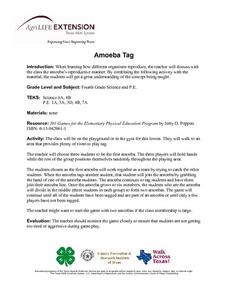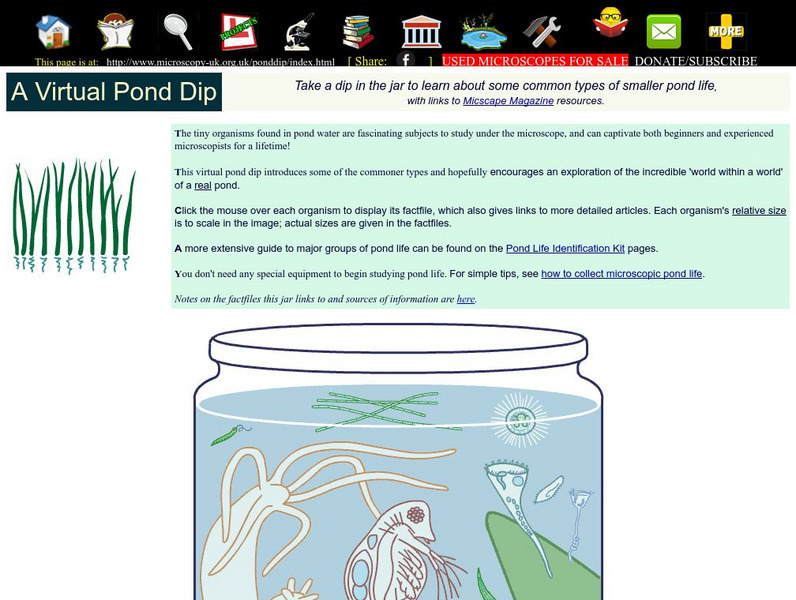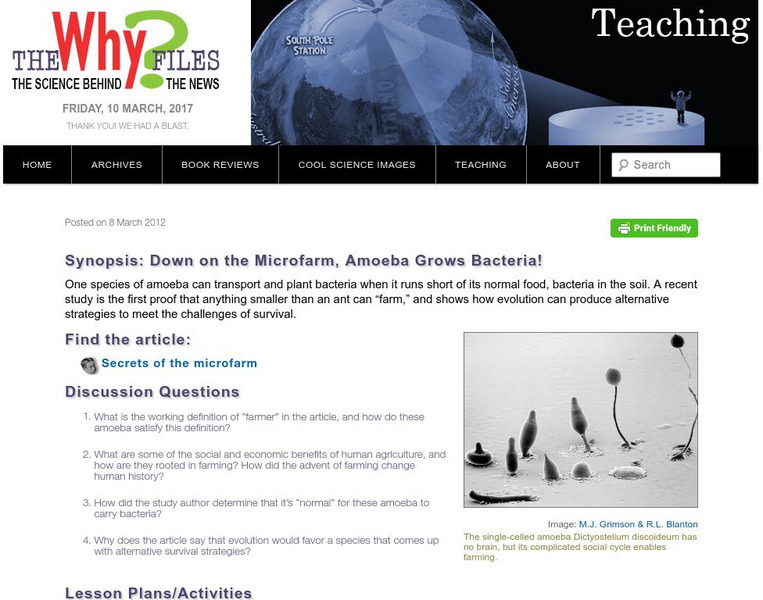Curated OER
Cell Structures and Their Functions
Life science learners investigate live cells. They examine wet mount slides of cyanobacteria and Elodea plants. They peer into the dynamic microscopic world of protists. Afterward, they construct a model of a cell, including rudimentary...
Curated OER
Protists - The Protozoans
Five pages provide thorough coverage of three protozoans: euglena, amoebae, and paramecia. For each, junior biologists read factual text, label the organism, and write answers to several questions. This neatly organized assignment is...
Curated OER
Comparing the Amoeba to Paramecium
This laboratory activity is valuable practice in comparing features of different organisms. You could use it to introduce junior biologists to protozoans. The materials and procudures for the learners are simple, and analysis...
Curated OER
Amoeba
In this amoeba instructional activity, students read about the structures of the amoeba and their functions. They answer twelve questions about the amoeba and color given structures on a diagram of an amoeba.
Curated OER
How Do Single-Celled Organisms Live?
In this single-celled organisms worksheet, students write in how an amoeba, paramecium, and euglena move. Based on these facts, students come to a conclusion about how these organisms live. This worksheet has 4 short answer questions.
Curated OER
Biology: Cells and Chemical Changes
Students explore the numerous functions of cells in both plants and animals. Following a pre-assessment, they construct cell models and examine onion cell slides stained with iodine or dye. After participating in experiments on how to...
Curated OER
The Amoeba
In this amoeba worksheet, students read a selection about the amoeba, then answer a set of 7 comprehension questions and color and label a diagram of an amoeba.
Curated OER
The World of Protists
In this protists worksheet, students will look at 3 diagrams showing the steps of how an amoeba finds and eats its food. Students will complete 2 short answer questions based on the diagrams.
Curated OER
Amoeba Tag
Fourth graders investigate how different organisms reproduce by participating in a Amoeba Tag game. Students work as a team and try to catch each other -- thus "reproducing" amoebas.
Science Education Resource Center at Carleton College
Serc: Investigating Microbes in a Nature Center
In this Nature Center activity, students will identify microbes found in the pond and creek in the Eden Valley-Watkins Nature Center. They will collect samples using a Petri dish.
Microscopy UK
Microscopy Uk: The Smallest Page on the Web
Dive into a single drop of pond water to discover the microscopic world of freshwater organisms. Learn about protists, bacteria, and other tiny inhabitants that can only be seen under a microscope.
Microscopy UK
Microscopy Uk: A Virtual Pond Dip
In this site, you will be introduced to some of the more common organisms found in a pond. Contains a thorough guide to small and microscopic pond life with links to other descriptive sources.
Utah Education Network
Uen: Micro Organisms Don't Drink That Water
If you are looking for an introduction to protozoans and algae, this is a good place to start. You'll view some images of them and explore a few of their basic adaptations for survival.
Enchanted Learning
Enchanted Learning: Pond Life Animal Printouts
Filled with printable pages of both plant and animal pond life, Enchanted Learning features fact sheets with color pictures.
BiologyWise
Biology Wise: Classification and Characteristics of Protozoa
Discusses the general characteristics of protozoa and how they can be divided into different types based on their mode of locomotion, mode of nutrition, or mode of respiration. Includes a list of facts about protozoa.
University of Wisconsin
The Why Files: Down on the Microfarm
Explanation of how an amoeba can farm to make its own food when necessary.
My Science Site
Pond Water Plants and Animals [Pdf]
This resource depicts some pond water plants and animals one might happen to spot while peering through their microscope lense. This resource is in PDF form; requires Adobe Reader.
Exploratorium
Exploratorium: Microscope Imaging Station: Cell Motility
This interesting site explains how cells move and provides videos depicting the movement of various human and animal cells.
Middle School Science
Protist Lab
In this concise lab exercise, you will examine protists under the microscope, see examples of different protist types, and compare modes of locomotion.
Biology 4 kids
Biology4 Kids: Super Powered Protists
Meet the "big guys" on campus. Protists are the more advanced types of eukaryotes that are unique such as amoeba and slime molds.
BiologyWise
Biology Wise: Unicellular Organisms
A unicellular organism is made of only a single cell. Its characteristics are described and several examples are provided.
BiologyWise
Biology Wise: Examples of Protists
Explains what protists are and describes some examples.


















